jpwhit
New Member
I joined the forum a couple of months ago, but I've been doing my own solar and ESS builds for years. I've decided to post an overview of my system I installed at my lake house a few years ago. I'm also currently most of the way through a complete rip and replace at my main house, but I'll potentially cover that in another post later. It's similar to this install but has some nice updates and newer equipment.
First thing I should cover is my goals for the system. They are pretty simple really.
Here's a diagram showing the topology

In terms of equipment selection, the first set of panels I bought were 20 Heliene 360W panels, then later I bought a pallet of 38 Canadian Solar 400W panels on a clearance sale. I used Ironridge mounting hardware. Here's a couple of pictures of me mounting the panels on the roof.
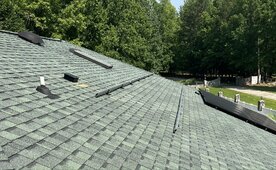

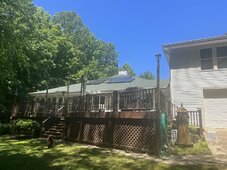
I started out planning to use SMA inverters. I had an earlier system based on two Sunny Island 6048 inverters along with Victron MPPT charge controllers and Tesla Model S battery modules. So, for this system I was planning to use a SMA Sunny Boy 7.7kw PV inverter and a Sunny Boy storage 6kw ESS inverter. I also decided early on that this system would be based on a high voltage battery system. My previous system was a 48V battery system and I wanted something more efficient and without the complication of heavy wiring, busbars, fuses etc.
But two things caused me to shift directions. First the order for my SB 7.7kw inverter was put on back order because SMA decided to suddenly phase them out and introduce their new line of all-in-one hybrid inverters. It was also turning out to be time consuming to reverse engineering the CANBUS battery interface on the Sunny Boy Storage inverter due to the proprietary nature of SMA.
For the inverter I came across GoodWe. GoodWe inverters aren't that well known in the US, but worldwide they are one of the biggest suppliers of inverters in the world. They are also on the approved equipment list in many states including California. And I checked with the local authorities where my houses are and there wasn't going to be any problem with getting them approved for grid tie. GoodWe inverters are also sold by GE in the US under their brand and they are now making a much stronger push into the US market. Net, net, I was convinced it was a good quality product that was well supported.
The other factor is GoodWe is not super proprietary about their stuff like a lot of other inverter manufactures. That made it much easier to figure out the battery interfaces.
I ended up deciding on the GoodWe GW9600A-ES all-in-one hybrid inverter. It has four 15 amp MPPTs that support 150% DC oversizing with up to 600V input. It supports grid-tie and off-grid operation as long as you install the associated autoformer. It has built-in energy monitor and tigo rapid shutdown support. It supports grid-zeroing if you want that and it has an economic mode where you can define time periods throughout the day and define exactly how you want it to behave during each time period. I also discovered just by use, that unlike some inverters that say they support DC over-provisioning the GoodWe will go way over 9.6 kw with my 14kw of panels. Since it's a DC coupled system between the panels and the batteries not all the power has to go through a DC to AC conversion. It's really common for me to see 13kw of power coming from the panels with some of that charging the batteries and the other part going to power the house or be fed into the grid.
It also has an acceptable mobile app and web based monitoring and reporting. I say acceptable because I've been able to get it do everything I need, but it could be better. But I will say it's gotten better and better over the time I've had it. Also because GoodWe isn't super proprietary I've seen all the interfaces needed to intergrate it into Home Assistant which is something I'll likely do in the future.
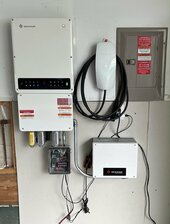
For the batteries for ESS I pretty quickly decided on using surplus Tesla Model 3/Y battery modules. I bought my Tesla Model Y new when they first came out. But for my 2nd Tesla I decided to buy 2 wrecked Model 3's and rebuild one good car out of them. Through that I was impressed with the quality of the Tesla batteries, their refined BMS system, and the long term durability.
But what really sealed the deal is the cost factor. There's simply no other way to get such high quality batteries for such a low price per KWH. I picked up my first set of 4 Tesla Model 3/Y modules for $1k because one of the modules had a bad cell group. Which rendered them useless for car, but perfect for fixed ESS storage. The cell group was bad because some of the fuse links in the module were broken. I just tig welded shunts across that cell group to make it a 95S pack instead of a 96S pack.
In terms of the amount of battery storage, I also knew I needed a bunch. Mainly because I was keenly following the debate going on between our power company and the utilities commission on a complete revamp of the Net Metering rate plans. And importantly the fact that the proposals were to only grandfather existing net metering customer into 1:1 credit for power sent to the grid until 2027. Also, in NC, anyone doing solar and net metering is going to be required to be on a TOU rate plan. Which I saw as another opportunity to reduce my payback period on the system by only buying any power from the grid at the lowest discount rate during the night. The discount rate is only $0.065 per KWH where the standard non-TOU rate here is about $0.12 per KWH. But the biggest driver of needing a lot of ESS capacity is I pretty much split my time 50/50 between the main and lake house along with a lot of KWH of EV charging. Basically, when I'm not at one of the houses, I bank all the extra power in the ESS system. Then when I arrive there is plenty of power to dump into the EV.
Here's a couple of pictures of the battery. This is showing just one dock box with modules, I have 2 now and changed the orientation of the modules to fit 6 in each box. It was also a requirement that the batteries not be inside the house for fire safety reason. But with a HV systems and the 10Ga wires required. The batteries don't need to be anywhere near the inverter.
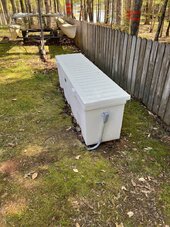

In terms of panels, rapid shutdown, and ESS shutdown I don't think it's worth going into a lot of details because it's pretty rudimentary stuff, so I'll mostly just post some pictures. I do have a completely integrated shutdown system. One switch handles a 100% shudown of all aspects of the system. Main panel on right, and main backup panel on left.
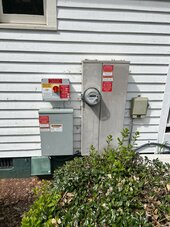
Garage backup sub-panel
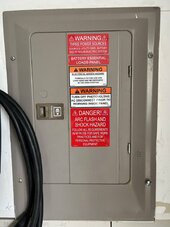
Dock backup sub-panel

Here's a graph of my last month's showing % of the power covered. This includes EV charging. The big dip at the beginning is when I had the system offline for a few days for some upgrades.
I should probably also mention I've made updates to the house to make it super energy efficient. I have 7 high efficiency pioneer minisplit systems installed so every bedroom has individual temperature control and only needs to be heated or cooled when in use. I have heat-pump based hot water heaters and heat-pump based clothes dryer.
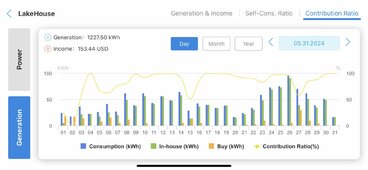
So what did it cost me:
20 Heliene 360W panels $2,400
16 Canadian Solar 400W panels. $1,695
GW9600A-ES $3,700
GW Autoformer $315
12 Tesla Model 3/Y Modules $7,500
Mounting hardware and Misc $1,800
Tigo Optimizer RSD Modules $1,200
Total $18,610
Savings per year
Electricity $4,200 (includes EV charging)
Payback Period 4.4 years
For EV Fans
Yearly gasoline saving over
the 2 BMW that Tesla's replaced. $5,600
First thing I should cover is my goals for the system. They are pretty simple really.
- Power backup during an outage - the lake house is in a rural area with a lot of above ground power lines. We lose power at least 2 times a month on average and I didn't want to invest in a backup generator
- I wanted the payback on the system to be 5 years or less - partly just because I wanted to see how economical I could build a system
- My wife and I are big into being environmentally conscience. We also drive a lot of miles because we go back and forth between the main and lake house at least once a week, and we have kids and grandchildren that we drive to visit often. We have 2 Tesla EVs, and we average about 35k miles a year on them. And I'm also almost done with a EV Ski Boat, but that's a project for another post. Anyway, I wanted to cover all the EV charging with Solar and ESS systems at the two houses.
- Keep the system as standard as possible. By occupation I'm a design engineer working in the industrial products market, but for this build I wanted to keep things as standard as possible such that if I were to sell the house, it could be maintained by anyone familiar with the standard solar installs. That means keep the custom-built electronics to a minimum and only where needed to save very significant costs.
Here's a diagram showing the topology

In terms of equipment selection, the first set of panels I bought were 20 Heliene 360W panels, then later I bought a pallet of 38 Canadian Solar 400W panels on a clearance sale. I used Ironridge mounting hardware. Here's a couple of pictures of me mounting the panels on the roof.



I started out planning to use SMA inverters. I had an earlier system based on two Sunny Island 6048 inverters along with Victron MPPT charge controllers and Tesla Model S battery modules. So, for this system I was planning to use a SMA Sunny Boy 7.7kw PV inverter and a Sunny Boy storage 6kw ESS inverter. I also decided early on that this system would be based on a high voltage battery system. My previous system was a 48V battery system and I wanted something more efficient and without the complication of heavy wiring, busbars, fuses etc.
But two things caused me to shift directions. First the order for my SB 7.7kw inverter was put on back order because SMA decided to suddenly phase them out and introduce their new line of all-in-one hybrid inverters. It was also turning out to be time consuming to reverse engineering the CANBUS battery interface on the Sunny Boy Storage inverter due to the proprietary nature of SMA.
For the inverter I came across GoodWe. GoodWe inverters aren't that well known in the US, but worldwide they are one of the biggest suppliers of inverters in the world. They are also on the approved equipment list in many states including California. And I checked with the local authorities where my houses are and there wasn't going to be any problem with getting them approved for grid tie. GoodWe inverters are also sold by GE in the US under their brand and they are now making a much stronger push into the US market. Net, net, I was convinced it was a good quality product that was well supported.
The other factor is GoodWe is not super proprietary about their stuff like a lot of other inverter manufactures. That made it much easier to figure out the battery interfaces.
I ended up deciding on the GoodWe GW9600A-ES all-in-one hybrid inverter. It has four 15 amp MPPTs that support 150% DC oversizing with up to 600V input. It supports grid-tie and off-grid operation as long as you install the associated autoformer. It has built-in energy monitor and tigo rapid shutdown support. It supports grid-zeroing if you want that and it has an economic mode where you can define time periods throughout the day and define exactly how you want it to behave during each time period. I also discovered just by use, that unlike some inverters that say they support DC over-provisioning the GoodWe will go way over 9.6 kw with my 14kw of panels. Since it's a DC coupled system between the panels and the batteries not all the power has to go through a DC to AC conversion. It's really common for me to see 13kw of power coming from the panels with some of that charging the batteries and the other part going to power the house or be fed into the grid.
It also has an acceptable mobile app and web based monitoring and reporting. I say acceptable because I've been able to get it do everything I need, but it could be better. But I will say it's gotten better and better over the time I've had it. Also because GoodWe isn't super proprietary I've seen all the interfaces needed to intergrate it into Home Assistant which is something I'll likely do in the future.

For the batteries for ESS I pretty quickly decided on using surplus Tesla Model 3/Y battery modules. I bought my Tesla Model Y new when they first came out. But for my 2nd Tesla I decided to buy 2 wrecked Model 3's and rebuild one good car out of them. Through that I was impressed with the quality of the Tesla batteries, their refined BMS system, and the long term durability.
But what really sealed the deal is the cost factor. There's simply no other way to get such high quality batteries for such a low price per KWH. I picked up my first set of 4 Tesla Model 3/Y modules for $1k because one of the modules had a bad cell group. Which rendered them useless for car, but perfect for fixed ESS storage. The cell group was bad because some of the fuse links in the module were broken. I just tig welded shunts across that cell group to make it a 95S pack instead of a 96S pack.
In terms of the amount of battery storage, I also knew I needed a bunch. Mainly because I was keenly following the debate going on between our power company and the utilities commission on a complete revamp of the Net Metering rate plans. And importantly the fact that the proposals were to only grandfather existing net metering customer into 1:1 credit for power sent to the grid until 2027. Also, in NC, anyone doing solar and net metering is going to be required to be on a TOU rate plan. Which I saw as another opportunity to reduce my payback period on the system by only buying any power from the grid at the lowest discount rate during the night. The discount rate is only $0.065 per KWH where the standard non-TOU rate here is about $0.12 per KWH. But the biggest driver of needing a lot of ESS capacity is I pretty much split my time 50/50 between the main and lake house along with a lot of KWH of EV charging. Basically, when I'm not at one of the houses, I bank all the extra power in the ESS system. Then when I arrive there is plenty of power to dump into the EV.
Here's a couple of pictures of the battery. This is showing just one dock box with modules, I have 2 now and changed the orientation of the modules to fit 6 in each box. It was also a requirement that the batteries not be inside the house for fire safety reason. But with a HV systems and the 10Ga wires required. The batteries don't need to be anywhere near the inverter.


In terms of panels, rapid shutdown, and ESS shutdown I don't think it's worth going into a lot of details because it's pretty rudimentary stuff, so I'll mostly just post some pictures. I do have a completely integrated shutdown system. One switch handles a 100% shudown of all aspects of the system. Main panel on right, and main backup panel on left.

Garage backup sub-panel

Dock backup sub-panel

Here's a graph of my last month's showing % of the power covered. This includes EV charging. The big dip at the beginning is when I had the system offline for a few days for some upgrades.
I should probably also mention I've made updates to the house to make it super energy efficient. I have 7 high efficiency pioneer minisplit systems installed so every bedroom has individual temperature control and only needs to be heated or cooled when in use. I have heat-pump based hot water heaters and heat-pump based clothes dryer.

So what did it cost me:
20 Heliene 360W panels $2,400
16 Canadian Solar 400W panels. $1,695
GW9600A-ES $3,700
GW Autoformer $315
12 Tesla Model 3/Y Modules $7,500
Mounting hardware and Misc $1,800
Tigo Optimizer RSD Modules $1,200
Total $18,610
Savings per year
Electricity $4,200 (includes EV charging)
Payback Period 4.4 years
For EV Fans
Yearly gasoline saving over
the 2 BMW that Tesla's replaced. $5,600






